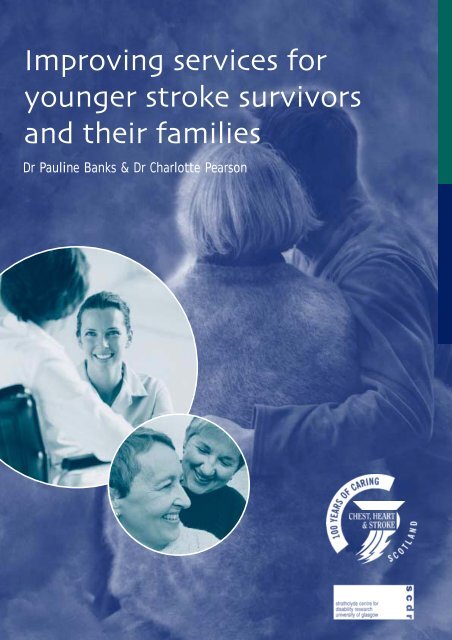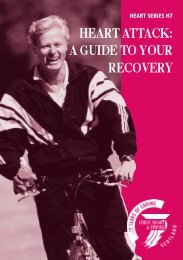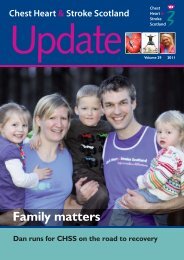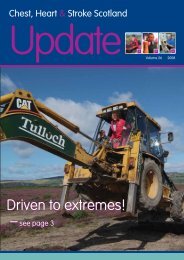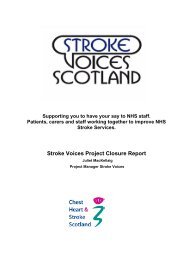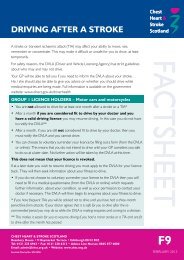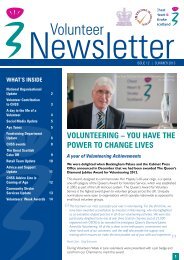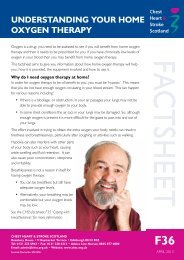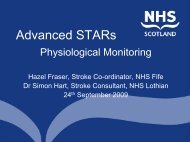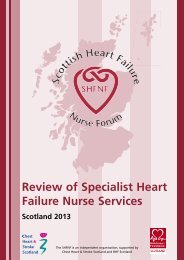Improving services for younger stroke survivors and their families
Improving services for younger stroke survivors and their families
Improving services for younger stroke survivors and their families
- No tags were found...
You also want an ePaper? Increase the reach of your titles
YUMPU automatically turns print PDFs into web optimized ePapers that Google loves.
<strong>Improving</strong> <strong>services</strong> <strong>for</strong><strong>younger</strong> <strong>stroke</strong> <strong>survivors</strong><strong>and</strong> <strong>their</strong> <strong>families</strong>Dr Pauline Banks & Dr Charlotte Pearson
ContentsExecutive Summary 2<strong>Improving</strong> <strong>services</strong> <strong>for</strong> <strong>younger</strong> <strong>stroke</strong> <strong>survivors</strong> <strong>and</strong> <strong>their</strong> <strong>families</strong> 4• Background 4• Method 5• Results 6Recognising <strong>stroke</strong> <strong>and</strong> seeking assistance 7Admission to hospital 10Inpatient stay 12Discharge from hospital 16Coping in the community 20Moving on 251• Continuing support 25• Depression <strong>and</strong> emotional changes 26• Employment 27• Financial impact 28• Impact on relationships 29References 32Acknowledgements 32<strong>Improving</strong> <strong>services</strong> <strong>for</strong> <strong>younger</strong> <strong>stroke</strong> <strong>survivors</strong> <strong>and</strong> <strong>their</strong> <strong>families</strong>
In addition, however, this report alsohighlights particular issues specificallyaffecting <strong>younger</strong> <strong>stroke</strong> <strong>survivors</strong> <strong>and</strong> <strong>their</strong><strong>families</strong>, including:• the impact of receiving acute care <strong>and</strong>rehabilitation within <strong>services</strong> cateringprimarily <strong>for</strong> older people• the difficulties experienced by relatives orcarers with family, employment <strong>and</strong> otherresponsibilities• the need <strong>for</strong> in<strong>for</strong>mation <strong>and</strong> enhancedsupport in areas including retraining,education, access to employment <strong>and</strong>welfare benefits• the key role which specialist <strong>stroke</strong> nursescan potentially play in providingindividualised support• the need to acknowledge <strong>and</strong> supportfamily <strong>and</strong> other carers3<strong>Improving</strong> <strong>services</strong> <strong>for</strong> <strong>younger</strong> <strong>stroke</strong> <strong>survivors</strong> <strong>and</strong> <strong>their</strong> <strong>families</strong>
<strong>Improving</strong> <strong>services</strong> <strong>for</strong> <strong>younger</strong><strong>stroke</strong> <strong>survivors</strong> <strong>and</strong> <strong>their</strong> <strong>families</strong>4This report presents the findings of a twoyear project funded by Chest, Heart <strong>and</strong>Stroke Scotl<strong>and</strong>, <strong>and</strong> carried out by theStrathclyde Centre <strong>for</strong> Disability Researchof the University of Glasgow.The aim of the research was to establishthe current provision <strong>for</strong> <strong>younger</strong> <strong>stroke</strong><strong>survivors</strong> (18-49) in Scotl<strong>and</strong>, <strong>and</strong>investigate the experiences of <strong>younger</strong><strong>stroke</strong> <strong>survivors</strong> (YSS), <strong>and</strong> <strong>their</strong> relatives orcarers in order to identify:•ways in which service provision <strong>for</strong> thisclient group could be improved•any potential barriers that may hinder asmooth return to independent livingBackgroundIn Scotl<strong>and</strong>, 4,598 adults of working age (18-64) were admitted to hospital following a<strong>stroke</strong> in the year 2000-2001. Of these,1,100 were aged less than fifty. However,because the incidence of <strong>stroke</strong> increaseswith age, service provision is often gearedtowards older individuals, neglecting theparticular needs <strong>and</strong> expectations of<strong>younger</strong> <strong>stroke</strong> <strong>survivors</strong> <strong>and</strong> <strong>their</strong> <strong>families</strong>.In addition to age, gender <strong>and</strong> deprivationare implicated in the incidence of <strong>stroke</strong>.Under the age of 45, there is littledifference between males <strong>and</strong> females.Above 45, however, incidence increasesmore rapidly amongst males than amongstfemales.There is a higher incidence of, <strong>and</strong>mortality from, <strong>stroke</strong> amongst people ofworking age (less than 65) living in deprivedareas. However, amongst people over 65there is no association with level ofdeprivation.The following chart shows the incidence of “young” <strong>stroke</strong> per thous<strong>and</strong>people of working age in Scotl<strong>and</strong> in 2000-2001:10987654321018-19 20-24 25-29 30-34 35-39 40-44 45-49 50-54 55-59 60-64MaleFemale<strong>Improving</strong> <strong>services</strong> <strong>for</strong> <strong>younger</strong> <strong>stroke</strong> <strong>survivors</strong> <strong>and</strong> <strong>their</strong> <strong>families</strong>
People who have a <strong>stroke</strong> experience asudden onset of disability; about half are leftwith a permanent h<strong>and</strong>icap 1 . Damage mayresult in both physical <strong>and</strong> mentalimpairment. Stroke impacts on both patient<strong>and</strong> <strong>their</strong> <strong>families</strong> 2,3 <strong>and</strong> research hasdemonstrated that many family care giversexperience difficulty coping with <strong>their</strong> caringrole.MethodThe study adopted a longitudinal approachcollecting data from young <strong>stroke</strong> <strong>survivors</strong>(YSS) <strong>and</strong> <strong>their</strong> relatives or carers (RorC),over a period of nine months, as well asfrom key in<strong>for</strong>mants including hospitalconsultants, <strong>stroke</strong> nurses, therapists,project managers, <strong>and</strong> voluntary sectorworkers.The first interviews were carriedout 3-6 months post-discharge fromhospital, <strong>and</strong> the second 6-9 months later.Between interviews participants wereinvited to keep a diary.The first interviews used the Lifegridmethod 4 , <strong>and</strong> took participants back tothree months prior to the <strong>stroke</strong>, in orderto ascertain what was happening in <strong>their</strong>lives at that time, <strong>and</strong> then covered theperiod up to the interview. Participants alsocompleted the SF36, which wasincorporated into the interview.The secondinterview took up from where the firstinterview finished, <strong>and</strong> built on in<strong>for</strong>mationderived from the diaries, where available.Although interested in all ‘<strong>younger</strong>’ adultsexperiencing a <strong>stroke</strong>, a decision was takento focus on those aged 18-49 years in orderto concentrate on individuals who werelikely to have been economically active <strong>and</strong>might have dependent <strong>families</strong>. FiftyYSS/RorC dyads were recruited at time 1,with 29 YSS <strong>and</strong> 24 RorC interviewed againat time 2.The research was carried out in four NHSHealth Boards across the central belt ofScotl<strong>and</strong>, with participants in the study livingin a variety of socio-economiccircumstances.Twenty-nine YSS were male <strong>and</strong> 21 female.Four out of five lived with the RorC whotook part in the study; six lived alone. Justunder half the YSS lived with dependentchildren/young people aged less than 20.Two-thirds of RorC were partners orspouses <strong>and</strong> another seven were parents,with the remainder were siblings, offspring,<strong>and</strong> friends. Two-thirds of RorC werefemale, <strong>and</strong> one third male; the youngestwas in <strong>their</strong> twenties, the oldest over 80.Interviews were taped <strong>and</strong> fully transcribed.Analysis of qualitative data was carried outusing NUDIST, a computer package <strong>for</strong> theanalysis of qualitative data. Quantitativedata were analysed using SPSS.5<strong>Improving</strong> <strong>services</strong> <strong>for</strong> <strong>younger</strong> <strong>stroke</strong> <strong>survivors</strong> <strong>and</strong> <strong>their</strong> <strong>families</strong>
6ResultsThe NHS in Scotl<strong>and</strong> is undergoing change,<strong>and</strong> while this research was being carriedout <strong>stroke</strong> <strong>services</strong> across the countrywere in a state of flux. We foundconsiderable disparity in the move toprovide care <strong>for</strong> more patients in <strong>stroke</strong>units, together with fast track clinics <strong>for</strong>people experiencing minor <strong>stroke</strong>s ortransient ischaemic attacks (TIAs). Despitedifferences in the rate of progress betweenhealth board areas the findings from thisstudy indicate that ‘seamless care’ continuesto be an aspiration rather than a reality.Stroke patients require a clear pathwayfrom the time of the event to maximumrecovery. Sufficient flexibility should beavailable to accommodate differences in age,gender, family commitments/circumstances,<strong>and</strong> of particular importance to <strong>younger</strong>people, what they are likely to be able toachieve in terms of returning toemployment. The findings from this studywill be presented in chronological order toreflect the patient journey:• Recognising <strong>stroke</strong> <strong>and</strong> seeking assistance• Admission to hospital•Inpatient stay• Discharge from hospital• Coping in the community•Moving onAs with all staged approaches some YSS willcomplete <strong>their</strong> journey more quickly thanothers. Recommendations focus on timeperiods or incidents, which resulted inparticipants in this study experiencingdifficulty or not feeling supported. In someinstances the same recommendations areincluded more than once so that issuesmissed at one stage will be picked up later.Examples of good practice are alsohighlighted.While some recommendationshave resource implications, others involveminor changes in working practice <strong>and</strong>/orawareness-raising amongst healthprofessionals.<strong>Improving</strong> <strong>services</strong> <strong>for</strong> <strong>younger</strong> <strong>stroke</strong> <strong>survivors</strong> <strong>and</strong> <strong>their</strong> <strong>families</strong>
Recognising <strong>stroke</strong> <strong>and</strong> seeking assistanceMuch of the in<strong>for</strong>mation in this section wasderived from relatives or carers, becausemany <strong>survivors</strong> remembered little about the<strong>stroke</strong> event <strong>and</strong> the time periodimmediately around it. YSS <strong>and</strong> <strong>their</strong> carersspoke of difficulty recognising the symptomsof <strong>stroke</strong>. They reported being reluctant tocontact GPs out of hours, or emergency<strong>services</strong>. A number of <strong>survivors</strong> <strong>and</strong> <strong>their</strong>carers reported having received a differentdiagnosis initially <strong>and</strong> being reticent aboutasking <strong>for</strong> further assistance.Several <strong>stroke</strong> <strong>survivors</strong> <strong>and</strong>/or <strong>their</strong> carersreported having experienced a great deal ofstress prior to the <strong>stroke</strong>, e.g. overwork,losing a job, family problems. Because wedid not have any <strong>for</strong>m of control group wedo not know how the daily lives of ourparticipants compared to other peopleliving in similar environments. Neverthelesswe believe that the events preceding the<strong>stroke</strong> are important in that they mayimpact on an individual’s resilience <strong>and</strong>ability to cope at that time.A number of YSS reported that <strong>their</strong> healthhad been poor <strong>for</strong> a long period prior to<strong>their</strong> <strong>stroke</strong>, while others recalled a gradualonset of illness <strong>and</strong> remarked that theywere perhaps aware of early symptoms <strong>and</strong>that something was wrong. Carersreported that the survivor had experiencedmood changes or altered behaviourpatterns prior to the <strong>stroke</strong>; in some casesthey had encouraged the YSS to visit <strong>their</strong>GP because they had felt that somethingwas wrong.Several YSS had experienced what <strong>their</strong>relative or carer described as a warningprior to the <strong>stroke</strong> event. Seven reportedhaving had at least one TIA, while othershad high blood pressure or heart problems.Other <strong>survivors</strong> felt that the <strong>stroke</strong> hadoccurred out of the blue, describing a fit <strong>and</strong>active lifestyle leading up to the event:“At the time I was fit, I went to the gym…I’mnot a heavy drinker <strong>and</strong> I eat the right things.Everyone kept saying ‘You’re the last person I’dexpect to suffer something like that.’”Several of the YSS confused <strong>their</strong> earlysymptoms with other conditions <strong>and</strong>delayed calling <strong>for</strong> medical help after <strong>their</strong>initial onset. A number were diabetic <strong>and</strong>attributed symptoms to the condition.There was a lack of awareness of theincreased risk of <strong>stroke</strong> amongst diabetics.Relatives’ or carers’ involvement in the<strong>stroke</strong> event varied with <strong>their</strong> relationshipto the <strong>stroke</strong> survivor <strong>and</strong> the timing ofonset. Realising that someone is in need ofhelp often falls to those around them at thetime, <strong>and</strong> it can be difficult <strong>for</strong> people torecognise what is happening <strong>and</strong> to thenchoose an appropriate course of action.The symptoms described by participantsvaried widely. Relatives or carers who werepresent when the <strong>stroke</strong> occurreddescribed the ambiguity of initial symptoms:“I thought I noticed something about herface… but I thought it was just myimagination…”7<strong>Improving</strong> <strong>services</strong> <strong>for</strong> <strong>younger</strong> <strong>stroke</strong> <strong>survivors</strong> <strong>and</strong> <strong>their</strong> <strong>families</strong>
8The majority of carers who were present atthe time of the <strong>stroke</strong> phoned <strong>their</strong> GP <strong>and</strong>requested a home visit. Only five reportedthat they had phoned an ambulancethemselves without first contacting <strong>their</strong> GP<strong>and</strong> six went directly to Accident &Emergency (A&E). Reluctance to botherGPs or call out emergency <strong>services</strong> can bemisinterpreted by health professionals whomay not appreciate how difficult thesedecisions are <strong>for</strong> people who have noprevious experience of ill health:“It’s a problem to decide whether someone isreally ill or not… in hindsight I’d wished I’ddialled 999…”One carer spoke at length of her feelings ofguilt following her husb<strong>and</strong>’s <strong>stroke</strong> – thehospital doctor had asked her why she hadwaited so long to seek help.Advice received by YSS who attended <strong>their</strong>local health centre varied. One carerexplained that her husb<strong>and</strong> had been toldto go straight to the hospital where he wasadmitted. However, he was not told that heshould not drive to the hospital. AnotherYSS who attended his GP was told that hehad probably had a slight <strong>stroke</strong>. He wassigned off work, given a prescription <strong>for</strong>aspirin, <strong>and</strong> told not to drive. He eventuallyreceived an appointment <strong>for</strong> an outpatientclinic more than six weeks after his <strong>stroke</strong>.Other YSS reported having been aware that‘something was wrong’ but had found itdifficult to persuade medical staff to explore<strong>their</strong> symptoms. One respondentexperienced particular difficulties when heattended an A&E Department with a sorehead <strong>and</strong> dizziness on New Year’s Day, anexceptionally busy time <strong>for</strong> hospital staff.Repeated visits to a busy A&E resulted in agreat deal of distress <strong>for</strong> the family be<strong>for</strong>ehis <strong>stroke</strong> was finally identified.Relatives or carers who were not presentwhen the <strong>stroke</strong> occurred reported verydifferent experiences. The shock of cominghome to find someone unconscious orreceiving a telephone call from a stranger isconsiderable.<strong>Improving</strong> <strong>services</strong> <strong>for</strong> <strong>younger</strong> <strong>stroke</strong> <strong>survivors</strong> <strong>and</strong> <strong>their</strong> <strong>families</strong>
Recommendations – recognising <strong>stroke</strong> <strong>and</strong> seeking assistance•Health promotion e.g. Wellwoman <strong>and</strong> Wellman clinics, posters <strong>and</strong> leaflets in GP surgeriesshould seek to raise public awareness of the symptoms of <strong>stroke</strong>, highlighting the fact thatit can affect <strong>younger</strong> people.•People at greater risk of <strong>stroke</strong> than the general population, e.g. those who haveexperienced a TIA, have high blood pressure, or diabetes should be made aware of therisk <strong>and</strong> symptoms which should prompt them to seek medical advice.•People experiencing minor <strong>stroke</strong> or TIA who are not admitted to hospital should haveaccess to a ‘one-stop’ neurovascular clinic within 7 days, ideally within 72 hours of <strong>their</strong>event as indicated in the Coronary Heart Disease <strong>and</strong> Stroke Strategy <strong>for</strong> Scotl<strong>and</strong> 5 .• GPs should be aware that <strong>stroke</strong> can affect <strong>younger</strong> people <strong>and</strong> that patients presentingwith symptoms of <strong>stroke</strong> should be investigated.• GPs who refer suspected <strong>stroke</strong>s to <strong>their</strong> local hospital should ascertain how patients areintending to travel <strong>and</strong> make arrangements where indicated.•Health professionals including GPs <strong>and</strong> staff in A&E departments should reassure patients<strong>and</strong> <strong>their</strong> <strong>families</strong> that they can seek further help or advice if the patient’s conditiondeteriorates or fails to improve.9<strong>Improving</strong> <strong>services</strong> <strong>for</strong> <strong>younger</strong> <strong>stroke</strong> <strong>survivors</strong> <strong>and</strong> <strong>their</strong> <strong>families</strong>
Admission to hospital10The majority of young <strong>stroke</strong> <strong>survivors</strong>were admitted to hospital through A&E. Innine of the hospitals involved in this studyacute care was provided through designated<strong>stroke</strong> units. Nevertheless participantsreported that the link between <strong>stroke</strong> <strong>and</strong>geriatric medicine was apparent. Where<strong>stroke</strong> units were not present or whenbeds were not available, admissions weremade through general medical wards. Intwo thirds of cases, the first day or two ofcare was spent on general wards prior tobeing moved to designated <strong>stroke</strong> care.More than half the YSS expressed specificunease at the hospital accommodation. Formany, being admitted to a ward with olderpeople caused considerable anxieties:“It was frightening in the hospital because theysaid,‘We’re going to take you up to the geriatricward…’ I tried to make a joke out of it, sayingthat I’m not a geriatric, but that was whereeverything was done.”Several YSS remarked on the differencesbetween the time spent on the generalmedical wards <strong>and</strong> the specialised <strong>stroke</strong>units, praising the <strong>stroke</strong> units.Almost all carers had some idea that the<strong>stroke</strong> survivor was being admitted <strong>for</strong>suspected <strong>stroke</strong> <strong>and</strong> that tests wouldrequire to be carried out. However, delaysin carrying out tests <strong>and</strong> inconclusive resultswere found to be unsettling.One carer reported that he had haddifficulty communicating with the hospitaldoctor. He felt that the doctor had nottaken advantage of his familiarity with theway in which his wife normally talked, <strong>and</strong>the ways in which her current speechdiffered from this:“The doctor didn’t quite pick it up… she waslosing the power of her speech… he wasn’tquite underst<strong>and</strong>ing what we were saying…”Relatives or carers reported varying levelsof satisfaction with in<strong>for</strong>mation received atthe time of admission. Leaflets that couldbe taken home were particularly popular:“They sat me down <strong>and</strong> they told me a goodbit… it made me feel a lot better… kind ofsettled me down. We brought some [leaflets]home <strong>and</strong> I’ve still got them…”However, it was apparent that some carersfound it difficult to cope with uncertainty:“I think [doctor in hospital] was just telling mewhat had happened <strong>and</strong> what I was looking <strong>for</strong>at the time was,‘What will happen from nowon?’ …obviously he couldn’t give me anyanswers because they just don’t know…”The level of satisfaction with in<strong>for</strong>mationreceived did not appear to be directlyrelated to the amount of in<strong>for</strong>mation givenby health professionals. While somerespondents stated that they found toomuch in<strong>for</strong>mation difficult to deal with,others reported having higher in<strong>for</strong>mationneeds. One carer felt that hospital staff didnot realise what a shock a young personhaving a <strong>stroke</strong> was to <strong>families</strong>, <strong>and</strong> howin<strong>for</strong>mation could easily confuse or upsetthem:<strong>Improving</strong> <strong>services</strong> <strong>for</strong> <strong>younger</strong> <strong>stroke</strong> <strong>survivors</strong> <strong>and</strong> <strong>their</strong> <strong>families</strong>
“I think people that’s working in wards with<strong>stroke</strong> people… they see so many people atdifferent states of disability that it’s every day…but to the relatives it’s a disaster…”The experience of another carer certainlysupports this assertion. On phoning toenquire how her husb<strong>and</strong>, who had beenadmitted the previous evening was gettingon, she was told that he was ‘fine’; howeverthe reality when she arrived at the hospitalwas somewhat different:“The doctor came <strong>and</strong> said they’d done all thetests <strong>and</strong> that he’d taken a small <strong>stroke</strong> – we’dhad no idea, nothing…”Recommendations – admission to hospital• Where possible all patients should be admitted to a specialist <strong>stroke</strong> unit, where they willbe looked after by a multi-disciplinary team as recommended in the Coronary HeartDisease <strong>and</strong> Stroke Strategy <strong>for</strong> Scotl<strong>and</strong> 5 .• In localities where, due to population density <strong>and</strong> socio-economic circumstances, there isa relatively high incidence of <strong>younger</strong> people experiencing <strong>stroke</strong>s, designated ‘<strong>younger</strong>’stoke units should be created. For example <strong>younger</strong> <strong>stroke</strong> patients could beconcentrated in one site in the larger cities.• Where <strong>younger</strong> <strong>stroke</strong> patients are treated in wards with a mixed age profile, healthprofessionals should be aware that being treated in close proximity to very elderlypatients is a major concern <strong>for</strong> <strong>younger</strong> people experiencing a <strong>stroke</strong> <strong>and</strong> <strong>their</strong> <strong>families</strong>.Patients <strong>and</strong> <strong>their</strong> <strong>families</strong> should be in<strong>for</strong>med, in a sensitive manner, that the best carecan be provided by admission to a <strong>stroke</strong> unit that caters <strong>for</strong> patients of all ages.• All health professionals should find ways of ensuring effective communication withpatients <strong>and</strong> <strong>their</strong> relatives in order to benefit from relatives’ knowledge of the patient in‘other’ circumstances.•Health professionals should keep relatives in<strong>for</strong>med about the nature of tests beingcarried out <strong>and</strong>/or diagnosis. Carers should be told the best times <strong>and</strong> methods ofcontacting staff when seeking in<strong>for</strong>mation about <strong>their</strong> relative.• In addition to discussions with relevant Stroke Consultants <strong>and</strong> specialist staff,YSS <strong>and</strong><strong>their</strong> <strong>families</strong> should be provided with written in<strong>for</strong>mation in plain English or otherlanguages where appropriate.• All staff should be aware that <strong>stroke</strong> is a unique <strong>and</strong> traumatic event <strong>for</strong> each family <strong>and</strong>that, particularly amongst <strong>younger</strong> people, <strong>their</strong> knowledge of <strong>stroke</strong> <strong>and</strong> its implicationsmay be limited.11<strong>Improving</strong> <strong>services</strong> <strong>for</strong> <strong>younger</strong> <strong>stroke</strong> <strong>survivors</strong> <strong>and</strong> <strong>their</strong> <strong>families</strong>
Inpatient stay12Length of inpatient stay is dependent on anumber of factors including case mix, nature<strong>and</strong> quality of inpatient care, <strong>and</strong> provision<strong>for</strong> discharge into the community. In thisstudy duration of inpatient stay ranged fromless than a day to 39 weeks. Overall thirty<strong>stroke</strong> <strong>survivors</strong> (60.0%) were dischargedafter less than two weeks, a much shorterperiod than the average inpatient stay of39.5 days reported in the NationalSentinel Stroke Audit 2001/02 5(Intercollegiate Stroke Working Party, 2002).As would be expected duration generallyreflected severity of <strong>stroke</strong>, some YSSrecovering most of <strong>their</strong> faculties almostimmediately, whereas others developedfurther complications following admission.Ten YSS were given rooms on <strong>their</strong> own <strong>for</strong>at least some of <strong>their</strong> inpatient stay. Thisplaced them separately from many of theolder patients on the wards <strong>and</strong> wasappreciated by both patients <strong>and</strong> <strong>their</strong><strong>families</strong>. Carers voiced <strong>their</strong> concernsabout the age range on wards. Onedescribed how being in a ward includingolder people had upset his wife who was inher <strong>for</strong>ties:“I thought there were too many elderly patientsall in the one unit <strong>for</strong> somebody as young asthat. One of them died actually… <strong>and</strong> shecould hear every word the priest was saying…I think that gave her a scare too… she wasupset…”Other issues relating to wards with a highnumber of older people included YSShelping other patients attract the nurse’sattention when they were distressed, feelingthat the older patients’ symptoms weremore severe than <strong>their</strong> own, <strong>and</strong> not havinganyone in a similar situation to talk to.The majority of YSS spoke positively aboutthe hospital staff. For example, participantsreported incidents where staff had beenespecially flexible <strong>and</strong> had taken intoaccount the specific needs <strong>and</strong>circumstances of <strong>younger</strong> patients <strong>and</strong> <strong>their</strong><strong>families</strong>, e.g. allowing family members to visitat any time. One YSS whose wife waspregnant at the time that he had his <strong>stroke</strong>,<strong>and</strong> gave birth whilst he was still in hospital,reported that staff were aware of events<strong>and</strong> helped him visit his wife <strong>and</strong> newborndaughter at the earliest opportunity.Young <strong>survivors</strong> <strong>and</strong> <strong>their</strong> carersacknowledged that accommodating <strong>younger</strong><strong>families</strong> in <strong>stroke</strong> wards with older peoplecould be difficult. Some hospitals operatedstrict visiting times, which carers foundparticularly difficult For example a numberof relatives or carers wanted to spend longhours at the hospital. Those who did nothave access to a car often found it difficultto marry public transport or offers of a liftwith rigid times. Carers with young childrenwho had to juggle going to work, hospitalvisits, <strong>and</strong> looking after other familymembers would also have benefited fromgreater flexibility.“I was coming back <strong>and</strong> getting the kids fromschool <strong>and</strong> feeding them, then if they wanted togo up at night <strong>and</strong> see <strong>their</strong> Mum, take themup at night. Or if they wanted to stay, see it<strong>Improving</strong> <strong>services</strong> <strong>for</strong> <strong>younger</strong> <strong>stroke</strong> <strong>survivors</strong> <strong>and</strong> <strong>their</strong> <strong>families</strong>
wasn’t a ward <strong>for</strong> taking the kids into… it wasall old people – so I was dropping them off ather friends or her sisters…”In some cases the inpatient stay involvedmore than one hospital,YSS being moved inorder to access specialist <strong>services</strong> or <strong>for</strong>rehabilitation. Moving between wardswithin a hospital was also common.However, it could be quite upsetting <strong>for</strong>relatives arriving to find an empty bed:“He was in the high dependency ward <strong>and</strong> hewas sitting all monitored… <strong>and</strong> when we wentin at night he wasn’t there…”In fact this patient had been taken to the<strong>stroke</strong> ward. However, his carer was facedwith a similar situation two days later whenshe had intentionally visited early to catchhim be<strong>for</strong>e he went <strong>for</strong> a scan – he hadalready been taken when she arrived.Patients received support from a mixture ofallied health professionals (AHPs) includingphysiotherapists, occupational therapists,speech <strong>and</strong> language therapists, in additionto <strong>stroke</strong> nurses during <strong>their</strong> hospital stay.Stroke nurses were found in a variety ofguises across the hospital sites <strong>and</strong> carerswho had contact with them reported thatthey were a valuable source of in<strong>for</strong>mation<strong>and</strong> support.The type <strong>and</strong> level of therapy receivedgenerally appeared to reflect clinicaldecisions; however, several participantsreported that speech therapy was lessreadily available than physiotherapy oroccupational therapy.“There was supposed to be a speech therapistcome… I think the speech therapist came theday she was getting out. I asked the staffnurse <strong>and</strong> she says… ‘Well we’ve other peopleto see…’”In addition to variations in the type <strong>and</strong>level of therapy received, the way in whichsupport was delivered <strong>and</strong> in<strong>for</strong>mationprovided by staff varied. In some casestherapists explained the purpose behindcertain tasks or exercises <strong>and</strong> drewattention to the implications <strong>for</strong> patients’own lives. One YSS whose wife wasexpecting a baby explained:“One day the physio said to me,‘I need to getyou walking… the baby is coming <strong>and</strong> I needto get you home.’”Another patient reported that he had beentaken out of the hospital into town to seehow he would cope in differentsurroundings:“For me a big thing was getting out of pyjamas<strong>and</strong> getting into normal clothes… I felt betterin myself because I was going into town.”Other examples included an OT who triedto replicate a survivor’s home kitchen intherapy sessions <strong>and</strong> another who usedtasks aimed at regaining skills needed in theworkplace.However, a number of YSS reported thatthey had no idea why they were asked tocarry out certain tasks or do particularexercises, which resulted in either apathy orresentment amongst patients <strong>and</strong> carers.13<strong>Improving</strong> <strong>services</strong> <strong>for</strong> <strong>younger</strong> <strong>stroke</strong> <strong>survivors</strong> <strong>and</strong> <strong>their</strong> <strong>families</strong>
14One YSS reported that he felt rushed <strong>and</strong>unsupported by his occupational therapist:“She showed me how to put a T-shirt on <strong>and</strong> Isaid… ‘How do I fasten my trousers…?’ <strong>and</strong>she said ‘Oh, you’ll get help’, <strong>and</strong> that was it.”Some <strong>survivors</strong> felt that rehabilitation hadnot started early enough following the<strong>stroke</strong>, Others thought the duration oftherapy sessions was too short, sometimesonly 5-10 minutes in a day. Attention wasdrawn to the lack of input at weekends.Carers reported that they did not feelinvolved in the care of the survivor whilethey were in hospital. While some admittedthat they were not in a position to judgewhether the provision was adequate or not,others reported that they did not knowwhat <strong>services</strong> were on offer, or that theywere unsure of the difference betweenprofessionals:“There was a speech therapist, or somebody tohelp him swallow… I think she was a speechtherapist…”A small number of carers who wereavailable during the day were encouraged togo to the hospital <strong>and</strong> help with exercisesor tasks which gave them a feeling ofinvolvement.Carers raised a number of issues regardingfood in the hospital, particularly in generalwards:“The nurses were telling me that he refused toeat anything because [I] was cooking stuff <strong>and</strong>bringing it in, but on the other h<strong>and</strong>… theywere bringing things like chicken curry, <strong>and</strong>steak, <strong>and</strong> he couldn’t eat them…”The majority of patients who were in a<strong>stroke</strong> ward fared better. However, onecarer felt that her husb<strong>and</strong>’s food <strong>and</strong> drinkhad not being monitored adequately causinghis diabetes to become unstable.Relatives or carers reported that it was notalways easy to access in<strong>for</strong>mation; it wassuggested that staff did not volunteerin<strong>for</strong>mation <strong>and</strong> that they had to seek it out<strong>for</strong> themselves. Others drew attention tothe problems associated with only visiting inthe evenings when therapy staff were noton duty.A number of carers drew attention to thebenefits of having someone else with themwhen receiving in<strong>for</strong>mation or of coming tothe hospital with a written list of questions.In<strong>for</strong>mation leaflets were popular with<strong>survivors</strong> <strong>and</strong> carers, both <strong>for</strong> <strong>their</strong> content<strong>and</strong> because they could be taken home <strong>and</strong>re-read when verbal in<strong>for</strong>mation might be<strong>for</strong>gotten.<strong>Improving</strong> <strong>services</strong> <strong>for</strong> <strong>younger</strong> <strong>stroke</strong> <strong>survivors</strong> <strong>and</strong> <strong>their</strong> <strong>families</strong>
Recommendations – Inpatient stay• Where possible all patients should be treated on a specialist <strong>stroke</strong> unit as recommendedin the Coronary Heart Disease <strong>and</strong> Stroke Strategy <strong>for</strong> Scotl<strong>and</strong> 5• Where <strong>younger</strong> <strong>stroke</strong> patients are treated in wards with a mixed age profile, healthprofessionals should be aware that being treated in close proximity to very elderlypatients is a major concern <strong>for</strong> <strong>younger</strong> people experiencing a <strong>stroke</strong>, <strong>and</strong> <strong>their</strong> <strong>families</strong>.Patients <strong>and</strong> <strong>their</strong> <strong>families</strong> should be in<strong>for</strong>med, in a sensitive manner, that the best carecan be provided by admission to a <strong>stroke</strong> unit that caters <strong>for</strong> patients of all ages.•YSS should have access to all members of a multi-disciplinary team including speech <strong>and</strong>language therapy <strong>and</strong> clinical psychology where indicated.•Attention should be paid to st<strong>and</strong>ardising the role of <strong>stroke</strong> nurses, which should includeliaising with <strong>and</strong> acting as a contact <strong>for</strong> <strong>families</strong>.• Relatives or carers should be kept in<strong>for</strong>med of progress <strong>and</strong> plans <strong>for</strong> furtherinvestigations that are to be carried out.• Allied health professionals including physiotherapists, occupational therapists, <strong>and</strong> speech<strong>and</strong> language therapists should work in partnership with patients <strong>and</strong> <strong>their</strong> <strong>families</strong>,explaining the purpose behind specific tasks or procedures.15• Issues relating to employment should be addressed immediately post-<strong>stroke</strong>.Occupational therapists should ensure that they are aware of the previous employmentstatus of YSS in order to address possible alternatives at an early stage.• Visiting hours should be flexible in order to accommodate the needs of <strong>families</strong> withchildren visiting <strong>younger</strong> <strong>stroke</strong> patients, particularly if the patient is being treated on amixed age ward.• Relatives who have difficulty visiting during the day because of work commitments shouldbe notified of the best times <strong>and</strong> methods of contacting staff when seeking in<strong>for</strong>mationabout <strong>their</strong> relative.• Where <strong>families</strong> include children or young people <strong>stroke</strong> nurses should ascertain whetherthere are any difficulties <strong>and</strong> provide written in<strong>for</strong>mation appropriate to <strong>their</strong> age group.<strong>Improving</strong> <strong>services</strong> <strong>for</strong> <strong>younger</strong> <strong>stroke</strong> <strong>survivors</strong> <strong>and</strong> <strong>their</strong> <strong>families</strong>
Discharge from hospital16All <strong>stroke</strong> <strong>survivors</strong> described <strong>their</strong> relief atleaving hospital. However, returning homebrought with it a new set of problems asthe reality of <strong>stroke</strong>, impairment, <strong>and</strong>changes in <strong>their</strong> day to day living becameapparent:“When you’re in hospital, you don’t really thinkabout how your life is going to be when youleave… You think that you’ll just carry on asbe<strong>for</strong>e but you don’t.You get home <strong>and</strong> that’swhen the trauma starts.”Although the timing of discharge was basedon clinical decisions, the level <strong>and</strong> nature ofpreparation differed between cases.Relatives or carers reported having had‘some idea’ of when <strong>their</strong> relative or friendwas likely to be discharged, based on <strong>their</strong>progress <strong>and</strong> assessment of the homeenvironment. Nevertheless, a number werequite surprised by how quickly the survivorwas sent home:“We didn’t expect her to get out… I got aphone call after dinnertime on the Thursday tocome <strong>and</strong>… come <strong>and</strong> collect her…”Most longer-stay patients spent at least oneweekend at home prior to full discharge.This was a significant stage <strong>for</strong> both the YSS<strong>and</strong> <strong>their</strong> family, particularly <strong>for</strong> YSS whowere unable to return to <strong>their</strong> own homesin the first instance – e.g. three YSSreturned to <strong>their</strong> parental home initially ondischarge.The majority of <strong>survivors</strong> <strong>and</strong><strong>their</strong> carers reported that vital aids oradaptations were provided prior todischarge or as soon as possible thereafter,e.g. internal h<strong>and</strong>rails or wheelchairs. Anumber reported that they would need tomove to more suitable housing, e.g. groundfloor accommodation.Some carers felt that they had little inputinto decisions about discharge, <strong>and</strong> thatthey were ill-prepared despite the YSShaving had a weekend at home:“So he got out on the Friday <strong>and</strong> it was hardgoing at the weekend… I phoned on theMonday <strong>and</strong> you really couldn’t turn round <strong>and</strong>say ‘Take him back…’ that was him out, justlike that.”Only one relative or carer reported thatshe had been invited to a case conferenceinvolving members of a multi-disciplinaryteam in order to look at options <strong>for</strong> herpartner’s future.Carers drew attention to the worriesassociated with taking over responsibility<strong>for</strong> someone who had recently experienceda <strong>stroke</strong>. Level of anxiety was generallyrelated to the severity or mix ofimpairments, the suitability of housing, <strong>and</strong>any co-morbid conditions, e.g. a number ofcarers supporting <strong>survivors</strong> who werediabetic reported problems with stabilising<strong>their</strong> condition:“I can only imagine it’s like looking after a newbornbaby… your mind’s totally focussed on itall the time… the first couple of days [after]he came out of hospital… he slept a lot, buteven if he turned over… I would be back upthe stairs,‘Are you all right?’”A small number of YSS were dischargedearly as part of a Supported DischargeScheme. This proved to be popular withboth <strong>survivors</strong> <strong>and</strong> carers because <strong>services</strong>,<strong>Improving</strong> <strong>services</strong> <strong>for</strong> <strong>younger</strong> <strong>stroke</strong> <strong>survivors</strong> <strong>and</strong> <strong>their</strong> <strong>families</strong>
e.g. physiotherapy <strong>and</strong>/or occupationaltherapy, were put in place more quickly thanwas the case <strong>for</strong> the majority of thosedischarged into the community. However,speech <strong>and</strong> language therapy was notincluded in the package <strong>and</strong> had to bearranged separately. One carer whosehusb<strong>and</strong> ‘couldn’t speak at all’ whendischarged from hospital received nospeech <strong>and</strong> language therapy <strong>for</strong> over fourweeks post-discharge.For many carers, worries focussed aroundphysical impairment, <strong>for</strong> example managingstairs <strong>and</strong> safety in the kitchen <strong>and</strong>bathroom:“I would have liked a bit more advice in thehospital… at the time I didn’t know what toask…. when he first came out I tried to givehim a bath, but I couldn’t get him out the bathagain, I just had absolutely no idea of what todo or anything…”Visual impairments, inability tocommunicate, poor memory, <strong>and</strong> lack ofconcentration also caused difficulty. Carersfelt that therapists did not always thinkthrough all the implications of multipleimpairments:“He’s got a PEG tube going into his stomachbecause of his swallow… At first, when I wasoff <strong>for</strong> the first week, that was when I first didit… but after that they thought,‘Oh, he’ll beable to manage it himself…’ but he reallycouldn’t… obviously he has to do it with oneh<strong>and</strong>.”Survivors <strong>and</strong> <strong>their</strong> carers reported varyinglevels of support immediately followingdischarge. For the majority of YSS there wassome delay be<strong>for</strong>e <strong>services</strong> includingphysiotherapy, occupational therapy, speech<strong>and</strong> language therapy, <strong>and</strong> <strong>stroke</strong> nurses,were in place, which was an additionalconcern <strong>for</strong> both the YSS <strong>and</strong> the carer,who often had to chase up appointments.Several YSS found themselves without<strong>services</strong> <strong>for</strong> significant periods afterdischarge, despite being told that contactwould be made soon after coming home.Survivors <strong>and</strong> <strong>their</strong> carers felt that progressmade in hospital was being lost throughdelays in receiving key <strong>services</strong> after cominghome. They reported being frustrated bythe gap <strong>and</strong> feeling that nobody cared:“You felt like you were being penalised <strong>for</strong>going home… because if you stayed in hospitalyou would have got [physiotherapy] every day.”There was also confusion about whyparticular <strong>services</strong> were being offered orwithdrawn. Communication betweenservice providers <strong>and</strong> YSS was found to bepoor. For example, a survivor who movedfrom one area to another receivedphysiotherapy in her new area, having beentold that she did not require it where shelived be<strong>for</strong>e. Survivors <strong>and</strong> carers alsoquestioned the level <strong>and</strong> duration ofsupport received, often feeling that it waswithdrawn very quickly:“That’s it finished now. They said,‘You don’tneed to come back.’ I would have thought thatshe needed a wee bit more physio… I was verysurprised that they cut off the physio sosuddenly…”17<strong>Improving</strong> <strong>services</strong> <strong>for</strong> <strong>younger</strong> <strong>stroke</strong> <strong>survivors</strong> <strong>and</strong> <strong>their</strong> <strong>families</strong>
18The role of <strong>stroke</strong> nurses in the periodaround discharge varied considerably.Whereas some YSS received significantsupport from the <strong>stroke</strong> nurse during thisperiod, others had had only limited contact.Both YSS <strong>and</strong> <strong>their</strong> carers who had hadcontact with a <strong>stroke</strong> nurse post-dischargepraised the service, drawing attention to thepeace of mind associated with being able tocontact someone directly if they hadquestions:“She talks to you that you underst<strong>and</strong>… shedoesn’t use big words… if she does sheexplains what they are… It puts your mind atrest, at ease that you know you can phoneher…”Many <strong>survivors</strong> spoke of the fear of havinganother <strong>stroke</strong> during this period. Thecontrast between those able to freelyaccess in<strong>for</strong>mation <strong>and</strong> reassurance fromtrained personnel, <strong>and</strong> those without thisoption, was apparent.GPs have traditionally been seen as thegatekeepers to health <strong>services</strong>, <strong>and</strong> it wasapparent that YSS <strong>and</strong> <strong>their</strong> carers hadexpected a greater degree of support fromthem. While some YSS attended the localhealth centre regularly to pick upprescriptions or have <strong>their</strong> blood pressuremonitored, in many cases contact onlyinvolved collecting sick lines. One carerdescribed her disappointment at thesupport received following discharge:“It seems that the care in hospital was actuallyquite good, decent care <strong>and</strong> attention <strong>and</strong>thinking ahead… but things have sort of fallenapart…”The shock of having a <strong>stroke</strong> was difficult<strong>for</strong> respondents to deal with <strong>and</strong> <strong>for</strong> many<strong>survivors</strong> <strong>and</strong> carers the desire <strong>for</strong>in<strong>for</strong>mation <strong>and</strong> to know what had causedit was uppermost in <strong>their</strong> minds at thisstage, particularly those who felt that theyhad taken care of <strong>their</strong> health.<strong>Improving</strong> <strong>services</strong> <strong>for</strong> <strong>younger</strong> <strong>stroke</strong> <strong>survivors</strong> <strong>and</strong> <strong>their</strong> <strong>families</strong>
Recommendations – Discharge from hospitalPlanning•YSS, particularly those on mixed age wards, should be offered supported discharge asearly as possible. However, it is vital that the agreement <strong>and</strong> underst<strong>and</strong>ing of relatives issought prior to YSS being discharged.• Therapy should be organised in the community immediately on discharge. Where this isnot possible YSS <strong>and</strong> <strong>their</strong> <strong>families</strong> should be contacted <strong>and</strong> told how long they are goingto have to wait.In<strong>for</strong>mation• In addition to discussions with relevant Stroke Consultants <strong>and</strong> specialist staff,YSS <strong>and</strong><strong>their</strong> <strong>families</strong> should be provided with in<strong>for</strong>mation leaflets in plain English, or otherlanguages where appropriate.• All YSS <strong>and</strong> <strong>their</strong> <strong>families</strong> should be provided with in<strong>for</strong>mation, both face to face <strong>and</strong>leaflets, relating to 1) welfare benefits, 2) lifestyle changes, including changes in diet <strong>and</strong>smoking cessation, <strong>and</strong> 3) voluntary organisations working in <strong>their</strong> area.Stroke nurses•Attention should be paid to st<strong>and</strong>ardising the role of <strong>stroke</strong> nurses.This role shouldencompass liaison/advocacy <strong>and</strong> draw on many aspects of current practice – including theprovision of accessible specialist in<strong>for</strong>mation <strong>and</strong> linking different agencies, includinghealth, social <strong>services</strong>, employment, education, housing, the benefit agency, <strong>and</strong> voluntaryorganisations.19• All YSS discharged into the community should be visited by a <strong>stroke</strong> nurse within two daysof discharge. This early visit should identify <strong>and</strong> address any difficulties <strong>and</strong> provide theYSS <strong>and</strong> <strong>their</strong> family with a timetable of what is likely to happen in terms of service inputin the following weeks. The <strong>stroke</strong> nurse should continue to work with both the YSS <strong>and</strong>other family members as required.• Stroke nurses working in the community should be aware that young <strong>stroke</strong> <strong>survivors</strong> <strong>and</strong><strong>their</strong> carers are concerned about recurrence.Carers•Health professionals working with <strong>families</strong> should ensure that relatives or carers areaware that they may be regarded as a carer, the type of support that may be available, <strong>and</strong>that they have a right to a carer’s assessment. Particular attention should be paid tofamily members with multiple responsibilities, e.g. young children <strong>and</strong> employment, inorder to support them immediately following discharge.• Carers of YSS who are being discharged should be trained in lifting <strong>and</strong> h<strong>and</strong>ling if needed<strong>and</strong> any other tasks that they will carry out. They should be provided with a contacttelephone number should they have any queries.<strong>Improving</strong> <strong>services</strong> <strong>for</strong> <strong>younger</strong> <strong>stroke</strong> <strong>survivors</strong> <strong>and</strong> <strong>their</strong> <strong>families</strong>
Coping in the community20A desire to know where the <strong>stroke</strong> ‘hadcome from’ continued to preoccupy manyYSS, particularly those with no record of illhealth:“I’d not been to the doctors in 10 years… <strong>and</strong>then this happened.”Carers spoke of the ongoing worry of notknowing what caused the <strong>stroke</strong> <strong>and</strong> whatwas likely to happen in the future:“We don’t know… [the doctor] said hecouldn’t guarantee she wouldn’t take anotherone, <strong>and</strong> they say it could be worse nexttime… you just don’t know what to think,thinking it could happen any time again.”Some YSS <strong>and</strong> <strong>their</strong> carers who hadreported difficulty accessing in<strong>for</strong>mation feltthat health professionals either knewnothing about <strong>younger</strong> people <strong>and</strong> <strong>stroke</strong>or did not care.Lack of continuity of <strong>services</strong> continued toaffect YSS <strong>and</strong> in some cases had a markedimpact on <strong>their</strong> ability to cope. In somecases administrative errors were blamed <strong>for</strong>delayed or missed appointments, otherswere held back because of the pressure on<strong>services</strong>. In one case, there was a six-weekwaiting list <strong>for</strong> speech therapy; in another,the day care centre with key therapy<strong>services</strong> specifically <strong>for</strong> those under 65 hada waiting time of 16 weeks.“Stay in house all day just thinking abouteverything. Pain still in legs, arms <strong>and</strong> hips. Stillno word from hospital about appointments…”Survivors <strong>and</strong> carers reported a lack oflocal <strong>services</strong> <strong>for</strong> <strong>younger</strong> people, <strong>and</strong> drewattention to the need <strong>for</strong> contact withpeople in a similar age group. For themajority of YSS key therapy <strong>services</strong> wereprovided through local day hospitals. Onceagain, this placed YSS in contact withsignificantly older <strong>stroke</strong> <strong>survivors</strong>. Onesurvivor suggested that he had differentexpectations of what he wanted to achievethan other attendees:“They take them in at 10 o’clock in themorning <strong>and</strong> they’re basically <strong>for</strong>gotten aboutother than the time they’re being treated.They’re elderly, they’re tired, <strong>and</strong> they’ve suffered<strong>stroke</strong>s. And it makes you feel,‘Am I like them?’It puts you on a bit of a low.”Some YSS reported a lack of communicationwith therapists who failed to explain whythey were doing particular things or todraw attention to progress:“Today I had rehab. I think it went OK but theynever tell you how you have done.”However, other <strong>survivors</strong> reported a morepositive experience <strong>and</strong> a feeling of beinginvolved in <strong>their</strong> care:“I had a good chat with my OT. She said I wasdoing well <strong>and</strong> to keep positive. It is nice to beable to talk to a professional who underst<strong>and</strong>swhat I am going through.”Transport to physiotherapy or OT sessionscould pose a problem when carers wereworking, <strong>and</strong> could not take the survivor, orbecause other available transport was notacceptable. One carer reported that, <strong>for</strong> avariety of reasons, the hospital transporthad failed to turn up <strong>for</strong> four weeks in arow. Another explained that his wife hadstopped attending because the time spent<strong>Improving</strong> <strong>services</strong> <strong>for</strong> <strong>younger</strong> <strong>stroke</strong> <strong>survivors</strong> <strong>and</strong> <strong>their</strong> <strong>families</strong>
travelling on hospital transport faroutweighed the benefits derived from abrief physiotherapy session:“It’s her choice, but simply she feels that sort often minutes out of her day, you know… to bestuck in a place <strong>for</strong> a full day <strong>for</strong> ten minutes[physiotherapy]…”The role of the <strong>stroke</strong> nurse remainedimportant to <strong>families</strong> who received thisservice. Carers spoke of the benefits ofknowing that they could telephonesomeone <strong>and</strong> speak to them directly:“We phoned her one time… just not long after[husb<strong>and</strong>] came out, I felt his speech had gotworse again… She was very helpful… sheknew that we were worried about him…”.Although <strong>survivors</strong> <strong>and</strong> <strong>their</strong> carers hadexpressed satisfaction with the provision ofaids <strong>and</strong> adaptations on discharge, thesewere often the minimum required to enableYSS to leave hospital. In many cases therewas a significant delay be<strong>for</strong>e more costlyitems such as showers <strong>and</strong> bath chairs wereprovided. The initial focus on enabling YSSto manage in <strong>their</strong> own homes often failedto include access to the outside world.Lack of ramps <strong>and</strong> external h<strong>and</strong>rails meantthat many <strong>survivors</strong> became virtuallyhousebound. In other cases carersreported that equipment supplied wasunsuitable, <strong>and</strong> that alternatives were rarelyoffered.The level of in<strong>for</strong>mal support received byYSS <strong>and</strong> <strong>their</strong> primary caregiver, e.g. fromextended family, varied considerably.Where there was no additional support asmall number of YSS received a home helpservice. This was predominantly in caseswhere the survivor was living alone or wasseverely affected by <strong>their</strong> <strong>stroke</strong>. However,one carer reported that the home helpservice was too rigid <strong>and</strong> thus inappropriate<strong>for</strong> the YSS.Both <strong>survivors</strong> <strong>and</strong> carers spoke aboutlifestyle changes they had made, or neededto make following the <strong>stroke</strong>. However,input from health professionals variedconsiderably between areas, <strong>and</strong> there wascriticism of the lack of support receivedwhen trying to lose weight or give upsmoking.Emotional change was a particular problemin the early months after discharge. Overhalf the YSS spoke of feeling less able tocope following the <strong>stroke</strong> <strong>and</strong> becomingincreasingly frustrated:“I just feel emotionally very unstable <strong>and</strong> I’vegot a shorter fuse than I used to have. I usedto be able to cope with a lot of things <strong>and</strong> nowI just want to lash out.”However, the management of depressiveepisodes <strong>and</strong> nature of support offeredvaried considerably. By three to six monthspost-discharge, two-thirds of the YSS whowere experiencing depressive symptomshad not received any medical or serviceintervention <strong>and</strong> spoke of ‘muddling through’.Two <strong>survivors</strong> were in regular contact withpsychiatric <strong>services</strong>; one had admittedhimself voluntarily to a psychiatric unit <strong>for</strong> aweek, <strong>and</strong> the other received regular visitsfrom a psychiatric nurse with whom he hadbeen in contact prior to his <strong>stroke</strong>.21<strong>Improving</strong> <strong>services</strong> <strong>for</strong> <strong>younger</strong> <strong>stroke</strong> <strong>survivors</strong> <strong>and</strong> <strong>their</strong> <strong>families</strong>
22Carers spoke of difficulty coping with theextra dem<strong>and</strong>s on <strong>their</strong> time. One whowas already working full-time <strong>and</strong> had afamily to look after explained that thephysiotherapist had suggested that she helpwith exercises at home when this servicewas withdrawn. Although many carersreported that they were struggling, few hadbeen asked if they were coping. Those whosought help were rarely offered any <strong>for</strong>m ofcounselling:“I knew I wasn’t coping a long time ago, Ithought I would get by, but I didn’t… I’m onanti-depressants now… I was totally crackingup be<strong>for</strong>e; I was crying all the time…”Having free time was not easy <strong>for</strong> carers.One explained that she had becomehousebound following the <strong>stroke</strong>:“Be<strong>for</strong>e the <strong>stroke</strong> I went out sometimes, now Ihave a responsibility… I [used to] go shopping,out with my husb<strong>and</strong>, out with my baby… allthat’s very difficult <strong>for</strong> me after <strong>stroke</strong>.”It was apparent at this stage that the <strong>stroke</strong>had had a significant impact on relationshipsbetween <strong>survivors</strong> <strong>and</strong> those close to them.A number of participants spoke openlyabout <strong>their</strong> unease at partners <strong>and</strong> childrenassuming a caring role <strong>and</strong> the impact of<strong>their</strong> mood changes on <strong>their</strong> relationships.Carers spoke of difficulty in coping with thesurvivor’s emotional problems.Twenty-two households included childrenor young people aged less than twenty.Explaining that a parent has had a <strong>stroke</strong><strong>and</strong> dealing with questions fromchildren/young people of different ages canbe difficult. However, it was apparent thatparents in this study had differentperceptions of the level of in<strong>for</strong>mation thatchildren <strong>and</strong> young people were able tocope with. One carer talked about thechange in <strong>their</strong> household:“Sometimes I think they feel it hard… he’s[father] kind of moody <strong>and</strong> snappy… it’s kindof hard <strong>for</strong> me being in between them, youknow.”Carers spoke of the difficulties ofsupporting <strong>survivors</strong> when they were havingdifficulty coping themselves:“I keep telling him that it won’t be long be<strong>for</strong>ewe’re back at the football but I know he’s notentirely convinced. Neither am I.”An acute event such as <strong>stroke</strong> affects theday to day activities of the whole family.Three-quarters of the carers who had beenworking at the time of the <strong>stroke</strong> reportedthat they had taken time off work, four hadnot returned three to six months postdischarge from hospital <strong>and</strong> one hadreduced her hours.“I took time off <strong>and</strong> I’m still off just now… I’mputting in sick-lines… because I couldn’t h<strong>and</strong>lework when this happened… I was running upto the hospital twice a day… It was just a bittoo much to try <strong>and</strong> work <strong>and</strong> all, with the kids,<strong>and</strong>… it was just a bit too much…”One-third of the carers who took time offwere able to take paid leave; the rest tookannual holidays or sick leave. Returning towork was not an easy option <strong>for</strong> carers,who often expressed feelings of guilt or justfeeling unable to leave the YSS alone:<strong>Improving</strong> <strong>services</strong> <strong>for</strong> <strong>younger</strong> <strong>stroke</strong> <strong>survivors</strong> <strong>and</strong> <strong>their</strong> <strong>families</strong>
“I don’t know how quick he’s going to progress,at what point I’ll be able to leave him, but Imean I can’t go, there’s no way I could go backto work just now…”Carers who did return to employmentreported being exhausted, although onerelative drew attention to the benefits ofleaving the home <strong>for</strong> a period of time <strong>and</strong>the importance of her income <strong>for</strong> thewhole family.The financial impact of one or two adults ina household giving up work is considerable.Carers drew attention to the increasedexpenses incurred, <strong>for</strong> example travel <strong>for</strong>hospital visits, or extra heating bills inhouses which are not usually heated duringthe day. For some YSS <strong>and</strong> <strong>their</strong> <strong>families</strong>increased expenses in conjunction withreduced income, <strong>and</strong> in some instances noincome <strong>for</strong> a period of time, could result inspiralling debts.Survivors <strong>and</strong> carers were not automaticallygiven in<strong>for</strong>mation about welfare benefitswhen discharged from hospital, e.g. whichbenefits they might be entitled to or how toapply. Many reported having difficultyapplying, accessing in<strong>for</strong>mation orcompleting application <strong>for</strong>ms. One YSS whocontacted the Benefits Agency helplinefound the operator particularly unhelpful<strong>and</strong> unable to accommodate his visualimpairment incurred through the <strong>stroke</strong>.Those who did receive help, <strong>for</strong> examplefrom a social worker, were grateful <strong>and</strong>when benefits were awarded they weremuch appreciated:“We’ve got DLA, it came through, we’ve got thehigher rate <strong>for</strong> that… it’s lovely, it’s absolutelygreat, we’ve been given it <strong>for</strong> two years…”23<strong>Improving</strong> <strong>services</strong> <strong>for</strong> <strong>younger</strong> <strong>stroke</strong> <strong>survivors</strong> <strong>and</strong> <strong>their</strong> <strong>families</strong>
Recommendations – Coping in the communityServices• Members of <strong>stroke</strong> teams working in the community should be aware that YSS <strong>and</strong> <strong>their</strong>carers, particularly where the cause of <strong>stroke</strong> is unknown, are concerned aboutrecurrence. YSS should be in<strong>for</strong>med that relevant tests will be carried out as soon aspossible.•YSS should have access to therapists as required. Wherever possible YSS should receivetherapy with other <strong>younger</strong> people, e.g. through a physical disability team.• Therapists should work in partnerships with YSS, explaining the purpose behind specifictasks or procedures <strong>and</strong> in<strong>for</strong>ming them of progress.• Where <strong>services</strong> are being terminated YSS should be given advance notice. If appropriateYSS should be made aware of suitable exercise classes e.g. those organised by voluntaryorganisations. Greater use should be made of referrals to local gyms.• Homes should be re-assessed after discharge in order to ascertain if further adaptationsor equipment are required.24• Where appropriate YSS should be supported in making lifestyle changes, e.g. smokingcessation or dietary changes.Carers•YSS <strong>and</strong> <strong>their</strong> carers should be made aware that mood swings <strong>and</strong> depression areprevalent post-<strong>stroke</strong>. Families should be encouraged to discuss these issues <strong>and</strong> bereferred to a counsellor or psychologist if required.• The input of relatives <strong>and</strong> other supporters must be acknowledged. Health professionalsworking with <strong>families</strong> in the community should carry out carers’ assessments <strong>and</strong> monitorthe transition to caring, paying particular attention to family members with multipleresponsibilities e.g. young children <strong>and</strong> employment.Stroke nurses• Where <strong>families</strong> include children or young people <strong>stroke</strong> nurses should ascertain whetherthere are any difficulties <strong>and</strong> provide written in<strong>for</strong>mation appropriate to <strong>their</strong> age group.• Stroke nurses should provide support to carers as well as <strong>survivors</strong>, seeing them on <strong>their</strong>own in order to identify difficulties that they may be uncom<strong>for</strong>table discussing in thepresence of the YSS.• Stroke nurses in contact with <strong>families</strong> should ascertain whether or not carers were inemployment at the time of the <strong>stroke</strong> <strong>and</strong> ensure that support is in place to enable themto return to work.•YSS <strong>and</strong> <strong>their</strong> <strong>families</strong> needing support in the community should be offered the option ofreceiving Direct Payments which would enable them to organise <strong>their</strong> own <strong>services</strong>.<strong>Improving</strong> <strong>services</strong> <strong>for</strong> <strong>younger</strong> <strong>stroke</strong> <strong>survivors</strong> <strong>and</strong> <strong>their</strong> <strong>families</strong>
Moving onThe rate of physical progress varied.Whilesome YSS had fairly transient physicaldifficulties others were evidently frustratedby the slow speed of <strong>their</strong> recovery.“I just think it’s got worse…I still can’t use aknife <strong>and</strong> <strong>for</strong>k together, I can’t use two knittingneedles together…I can’t use the two h<strong>and</strong>s todo something…”Twelve to fifteen months post-dischargefrom hospital many YSS spoke of having‘good days <strong>and</strong> bad days’, some reported‘getting used to’ impairments, <strong>and</strong> being ‘morecom<strong>for</strong>table’ in themselves. However, othersfound acceptance much more difficult:“They [the hospital] offered me a walking stickbut I said,‘Get that thing away from me’, I’m nowanting a stick.”As the initial shock of the <strong>stroke</strong> lessenedsome <strong>survivors</strong> began to cope better withthe slow rate of progress <strong>and</strong> changedlifestyle. In a number of cases YSS whoappeared to have had more damage initiallyprogressed quickly. A small number of YSSexperienced secondary seizures. Difficultieswith speech presented a particular problem.One carer spoke of her disappointment atthe limited improvement in her husb<strong>and</strong>’scommunication; they had both hoped thathe would be able to speak by a year postdischargefrom hospital.Tiredness was prevalent; <strong>survivors</strong>commented that they ‘couldn’t do what theyused to do’. Even <strong>for</strong> those who hadregained much of <strong>their</strong> pre-<strong>stroke</strong> mobility,fatigue remained a problem:“It’s got to the stage when I can go to my bedat nine o’clock <strong>and</strong> be up at 10 in the morning<strong>and</strong> then I’m still shattered half an hour after Iget up.”Around half the YSS reported difficultieswith memory <strong>and</strong> concentration 12-15months post-discharge from hospital. Onlyone respondent reported using strategies toimprove his memory following advice fromhis OT. Difficulties <strong>and</strong> frustrationssurrounding access to therapy continued toaffect <strong>survivors</strong>, some of whom believedthat <strong>their</strong> progress had been hampered bylack of support. Access to speech <strong>and</strong>language therapy was a particular problem, asmall number of YSS with speech problemshaving had no support since leaving hospitalmore than a year previously:“I’ve never seen anybody… I’m still havingdifficulty expressing myself <strong>and</strong> [in] my writingas well… I get my words all mixed up <strong>and</strong> Idon’t finish the word.”Continuing supportYSS continued to receive input from a rangeof health professionals includingphysiotherapists, OTs, speech <strong>and</strong> languagetherapists, <strong>stroke</strong> nurses, <strong>and</strong> GPs asrequired. In a small number of cases<strong>survivors</strong> received support from a range ofprofessionals working together.This proved to be particularly effective asthe focus of input shifted with time. Forexample, one survivor who reported thathe had received support fromphysiotherapists <strong>and</strong> OTs in the early25<strong>Improving</strong> <strong>services</strong> <strong>for</strong> <strong>younger</strong> <strong>stroke</strong> <strong>survivors</strong> <strong>and</strong> <strong>their</strong> <strong>families</strong>
26stages, was later referred <strong>for</strong> psychologicalsupport.Thus there had been a shift fromdealing principally with physical damage to amore holistic approach encompassing hiscognitive abilities <strong>and</strong> mental wellbeing.Another YSS reported that he had receivedsupport from a physical disability teamworking in the community; this enabled himto receive support appropriate to his age<strong>and</strong> abilities rather than attending <strong>services</strong>primarily designed <strong>for</strong> older adults.A small number of <strong>survivors</strong> received homehelps <strong>and</strong> respite care; however, high levelsof support can have drawbacks:“You know, my house is taken over by otherpeople… <strong>and</strong> I like being able to do things <strong>for</strong>him as well… And then there’s the girls… Ihave this time limit, <strong>and</strong> that really frustratesme [but] be<strong>for</strong>e the respite I couldn’t even takethe girls <strong>for</strong> <strong>their</strong> tea.”More than half the YSS had been dischargedfrom the <strong>stroke</strong> support teams by a yearpost-discharge. However, the importance ofother support remained. For many<strong>survivors</strong>, the main points of contact <strong>and</strong>service provision was taken over by <strong>their</strong>GPs. In some cases YSS attended <strong>their</strong> localhealth centre <strong>for</strong> regular monitoring ofblood pressure, cholesterol etc. as well asaccess to more specialised <strong>stroke</strong>professionals. However, there was a lack ofconsistency across cases: <strong>for</strong> example, whilea small number of <strong>survivors</strong> were referredto smoking cessation clinics or dieticians,others received little or no help withaltering <strong>their</strong> lifestyle.Stroke nurses working in the communitycontinued to play an important part morethan a year post-discharge from hospital.YSS <strong>and</strong> <strong>their</strong> carers appreciated havingcontact with a named person. One carerreported that she had met with <strong>their</strong> <strong>stroke</strong>nurse on her own, highlighting the benefitsto be derived from <strong>stroke</strong> nurses havingtime to speak to both YSS <strong>and</strong> carer <strong>and</strong>offer a level of support.A small number of YSS who had moresevere residual impairments reported havingbeen re-housed or having major adaptationscarried out:“It’s [the shower] fantastic, the independencethat it gives me… I don’t need to be watchedbecause there’s a seat in the shower <strong>and</strong> youcan just put it down have your shower <strong>and</strong> thencome out.”However, not all cases had been dealt withso successfully. In a small number of cases<strong>survivors</strong> reported that they were confinedto <strong>their</strong> homes because of inadequateadaptations, or requests to be re-housed inground floor accommodation not beingmet.Depression <strong>and</strong> emotional changesDepression continued to be a problems 12-15 months post-discharge from hospital. Anumber of <strong>survivors</strong> who had experienceddepression earlier in <strong>their</strong> recoveryreported feeling better despite havingreceived either limited or no psychologicalsupport. However, a number of YSS whohad reported depression at time 1 felt thatthey had failed to improve over the months.<strong>Improving</strong> <strong>services</strong> <strong>for</strong> <strong>younger</strong> <strong>stroke</strong> <strong>survivors</strong> <strong>and</strong> <strong>their</strong> <strong>families</strong>
Despite being prescribed anti-depressantssome considered <strong>their</strong> depression to besignificantly worse by the time of thesecond interview.“There’s just too much going on in my head…Ijust feel as if nothing is happening <strong>and</strong> I’m notgetting any better.”The role of the GP was found to beimportant <strong>for</strong> YSS with depression.However, one survivor who spoke of hisinability to think positively about any aspectof his life reported that he found it difficultto talk about these issues with his GP orhis family.Carers spoke of the difficulties of managingthe physical <strong>and</strong> emotional changes causedby the <strong>stroke</strong> as well as trying to ameliorateits impact on <strong>their</strong> day to day family life.“I was just weak with just having to deal witheverything… you know with looking after[husb<strong>and</strong>], the children… having the houseadapted. I just went right downhill… I was ill<strong>for</strong> about 10, 12 weeks…”Despite the fact that almost three-quartersof YSS said that they would have foundtalking to other young <strong>stroke</strong> <strong>survivors</strong>helpful, only one had attended a supportgroup.EmploymentYSS spoke of the significance of work in<strong>their</strong> lives, both as a source of income <strong>and</strong> afacet of <strong>their</strong> identity. Returning to workwas perceived to symbolise ‘somethingnormal’ in day to day living.Of those who had been working at the timeof <strong>their</strong> <strong>stroke</strong>, one third had returned towork by three to six months post-dischargefrom hospital, two of whom had reduced<strong>their</strong> hours to part time in the firstinstance. Only another two YSS reportedhaving returned to work between the first<strong>and</strong> second interviews. Un<strong>for</strong>tunately, wedo not know how many of those who didnot take part at time 2 had returned towork. Seven <strong>survivors</strong> reported that theydid not expect to return to the sameoccupation, four did not expect to workagain. Young <strong>stroke</strong> <strong>survivors</strong> who did notexpect to return to the same employmentincluded those who had worked inphysically dem<strong>and</strong>ing jobs, drivers, <strong>and</strong> threewho had been self-employed at the time of<strong>their</strong> <strong>stroke</strong>s – all had lost <strong>their</strong> businesses.While a swift return to work must beviewed as a positive step, it was not withoutdifficulties, <strong>and</strong> some respondents reportedthat, in hindsight, they had perhaps returnedtoo soon. Young <strong>stroke</strong> <strong>survivors</strong> withcognitive impairments, e.g. memory loss,problems with speech, or depression, foundthe workplace to be an alien environmentcompared to that which they had left a fewmonths be<strong>for</strong>e:“Well, I’m really finding it quite a strain now,things I could cope with at this time last year, Ican’t cope with now, I mean I’ve really got toask <strong>for</strong> quite a bit of help.”Support from employers varied markedlybetween respondents. While some YSS felt‘let down’ by <strong>their</strong> employers, othersreported having received a great deal ofsupport. Two participants reported that<strong>their</strong> jobs had been reorganised to27<strong>Improving</strong> <strong>services</strong> <strong>for</strong> <strong>younger</strong> <strong>stroke</strong> <strong>survivors</strong> <strong>and</strong> <strong>their</strong> <strong>families</strong>
28accommodate <strong>their</strong> needs post-<strong>stroke</strong>.However, the changes were not alwayssuitable <strong>and</strong> it was apparent that employershad little underst<strong>and</strong>ing of the impact of<strong>stroke</strong> on <strong>their</strong> employees.Feeling hurt at an employer’s perceived lackof support quickly takes second place as thefinancial implications of not working beginto bite. Survivors employed on temporarycontracts found themselves out of workfollowing the <strong>stroke</strong> – often with little orno financial recompense. YSS who did nothave work-based sick pay reported beingunder considerable financial pressure toreturn as soon as possible.A number of <strong>survivors</strong> who were unable toreturn to <strong>their</strong> previous employment hadstarted taking an interest in re-training inorder to seek alternative work at the timeof the first interview. However, they foundit difficult to access in<strong>for</strong>mation aboutsuitable options <strong>and</strong> seemed to have lessconfidence about <strong>their</strong> prospects at twelveto fifteen months post discharge fromhospital than they had earlier. Onerespondent found his local collegeinaccessible, others felt that they could notcompete in the labour market:“I would like to go back to work, but I don’tknow what I can do.”Another YSS reported that he had made hisown enquiries into re-training <strong>and</strong> enrolledon a three-month computer <strong>and</strong> dataprocessing course. Whilst he had found thetransition into another area of work largelypositive, his applications <strong>for</strong> morepermanent employment had beenunsuccessful:“As soon as they [employers] hear that you’vehad a <strong>stroke</strong> they don’t want to know…”One survivor reported that he had beenencouraged to return to work by hisoccupational therapist <strong>and</strong> that his <strong>stroke</strong>nurse had helped him to enrol in acomputing course run specifically <strong>for</strong> <strong>stroke</strong><strong>survivors</strong>. Ultimately the course organiserliaised with his previous employernegotiating a staged return to work whichproved to be very successful.Financial impactHalf the YSS reported that <strong>their</strong> <strong>stroke</strong> hadhad a negative effect on <strong>their</strong> financialcircumstances, in some cases, <strong>survivors</strong>reported having experienced a substantialdrop in income <strong>and</strong> claimed that they hadhad to make considerable lifestyle changes.Both <strong>survivors</strong> <strong>and</strong> <strong>their</strong> carers expressedconcern about future finances:“You can’t buy things in the same way asbe<strong>for</strong>e because you say to yourself you don’tknow what’s around the corner.”Others had experienced problems with thebenefit system:“I put my claim in <strong>and</strong> they said it takes five orsix weeks to arrive, but it didn’t arrive, so Iphoned up about it <strong>and</strong> they said,‘Oh no,you’ve filled in the <strong>for</strong>m wrong…’ it was like youwere trying to con them.”A small number of participants reportedhaving had private health insurance whichpaid <strong>their</strong> mortgage.<strong>Improving</strong> <strong>services</strong> <strong>for</strong> <strong>younger</strong> <strong>stroke</strong> <strong>survivors</strong> <strong>and</strong> <strong>their</strong> <strong>families</strong>
Impact on relationshipsOne of the most striking aspects of theinterviews carried out twelve to fifteenmonths post-discharge from hospital wasthe impact on relationships between the<strong>survivors</strong> <strong>and</strong> <strong>their</strong> carers. Loss of workwith associated loss of income, depression,lack of social life, <strong>and</strong> general changes inlifestyle clearly took <strong>their</strong> toll. Whilerelatives or carers who were not coresidentcould withdraw, or distancethemselves to some extent, those who livedtogether, particularly partners or spouses,were often together 24 hours a day:“It’s a dramatic change. I don’t know if it’sbeen… to do with the <strong>stroke</strong>, or because I’mout of work, but we’re now both at home now,you know, <strong>and</strong> that’s a real change…”Both YSS <strong>and</strong> carers reported that theyfound communication difficult. Some<strong>survivors</strong> acknowledged that they wereoften short tempered, <strong>and</strong> spoke of feelingguilty:“I quite often lose my head with him[husb<strong>and</strong>]… I mean he’s been quite patientwith me but I don’t feel we talk enough… Idon’t tell him what I’m really feeling.”For carers on the receiving end it could bedifficult to know what to do next:“I suggest things <strong>and</strong> she just says,‘Don’tpatronise me, I don’t need your sympathy.’”Some carers felt that <strong>their</strong> partners hadchanged <strong>and</strong> that there was no way ofknowing if this was permanent, ortemporary:“I don’t know if the <strong>stroke</strong> has changed hispersonality, but it has certainly brought thingsto the <strong>for</strong>e…”A small number of carers reported thatcognitive impairments resulted in lack ofinhibition in <strong>survivors</strong> which they founddifficult to cope with:“He just talks about sex all the time… he justdoesn’t seem to bother who’s around whereasbe<strong>for</strong>e he was, you know, never like that.”In other cases YSS talked of medicationaffecting <strong>their</strong> sexual relationships <strong>and</strong> <strong>their</strong>sorrow at the resulting loss of closeness.The impact on family relationships was notlimited to couples. Carers spoke of tryingto maintain a balance between coping withthe needs of <strong>their</strong> partners <strong>and</strong> maintainingsome semblance of home life <strong>for</strong> <strong>their</strong>children. A small number expressedconcern over the impact of the <strong>stroke</strong> onchildren’s relationships with the YSS. Noneof the participants reported having receivedany guidance about the likely impact of the<strong>stroke</strong> on <strong>their</strong> relationships. One carerhad contacted marriage guidance <strong>and</strong> at thetime of the interview was waiting <strong>for</strong> anappointment. A small number had receivedsupport from <strong>stroke</strong> nurses, but thereappeared to be no system in place <strong>for</strong>supporting these <strong>families</strong>.Friendships too had been affected.Thereappeared to be a gender difference withfemales reporting that friends had ‘stuck bythem’, while the majority of male <strong>survivors</strong>reported that friendships had deteriorated:29<strong>Improving</strong> <strong>services</strong> <strong>for</strong> <strong>younger</strong> <strong>stroke</strong> <strong>survivors</strong> <strong>and</strong> <strong>their</strong> <strong>families</strong>
30“They never come near… I think they’refrightened.”Going out <strong>and</strong> meeting people is oftenimportant to couples. However, both young<strong>stroke</strong> <strong>survivors</strong> <strong>and</strong> <strong>their</strong> carers reportedthat it was not easy to re-establish <strong>for</strong>merroutines:“He just gets very tired… [Going out] is just alot of ef<strong>for</strong>t <strong>for</strong> him, <strong>and</strong> sometimes it’s sofrustrating because I mean we’re both stillyoung… It’s just all so entirely different...”Although the majority of couples reportedthat the <strong>stroke</strong> had had a negative impacton <strong>their</strong> relationship, this was not alwaysthe case. In some instances participants feltthat sharing the experience of the <strong>stroke</strong><strong>and</strong> subsequent rehabilitation had broughtthem closer together:“I think possibly this has brought us even closer,you know helping each other out… It’s been aterrible experience <strong>for</strong> both of us but… I don’tthink it’s damaged our relationship.”Just over a third of those interviewedtwelve to fifteen months post-dischargefrom hospital reported that they felt morepositive <strong>and</strong> ready to move on. A numberof <strong>survivors</strong> <strong>and</strong> carers claimed that the<strong>stroke</strong> had made them reassess <strong>their</strong> lives:“I used to go to my work, hammer into that,<strong>and</strong> then come home <strong>and</strong> start on doing thingsin the house… I had to take a step back…The <strong>stroke</strong> gave me a fright <strong>and</strong> I just takethings a bit more slowly now.”Positive events were important in helpingYSS move on from the <strong>stroke</strong>. During theperiod between the first <strong>and</strong> secondinterview, two <strong>survivors</strong> had becomegr<strong>and</strong>parents <strong>for</strong> the first time, <strong>and</strong> onewhose wife gave birth shortly after his<strong>stroke</strong> was enjoying his young daughter.Others spoke of the importance of beingable to drive again <strong>and</strong> the independencethis gave them. One survivor who receiveda grant to enable him to get an adapted carexplained:“It’s been absolutely fantastic… you just put itinto gear… <strong>and</strong> off you go”Recommendations – Moving onServices•YSS may require long-term follow up which should be provided by a multi-disciplinaryteam working in the community.•YSS should continue to have access to therapists as required, preferably in a setting withother <strong>younger</strong> people.• Particular attention should be paid to difficulties with speech <strong>and</strong> language, <strong>and</strong>/orcognitive impairments. YSS should be assessed <strong>and</strong> given support to enable them to copewith some of the difficulties, e.g. strategies to improve memory.•YSS <strong>and</strong> <strong>their</strong> carers should be aware that mood swings <strong>and</strong> depression are prevalentpost-<strong>stroke</strong>. Referral should be made <strong>for</strong> counselling or psychological support asrequired.<strong>Improving</strong> <strong>services</strong> <strong>for</strong> <strong>younger</strong> <strong>stroke</strong> <strong>survivors</strong> <strong>and</strong> <strong>their</strong> <strong>families</strong>
•Younger people who have experienced a <strong>stroke</strong> should be covered by a ‘high risk groupsapproach’ to <strong>stroke</strong> prevention <strong>and</strong> health improvement (Scottish Executive, 2002), <strong>and</strong> besupported in making lifestyle changes, e.g. smoking cessation or dietary changes.•YSS <strong>and</strong> <strong>their</strong> <strong>families</strong> needing support in the community should be offered the option ofreceiving Direct Payments which would enable them to organise <strong>their</strong> own <strong>services</strong>.• The input of relatives <strong>and</strong> other supporters must be acknowledged. Health professionalsworking with <strong>families</strong> in the community should ensure that a carer’s assessment has beencarried out.Employment• Issues relating to employment should be addressed. Therapists should ensure that theyare aware of the previous employment status of YSS in order to assess possible options<strong>for</strong> the future. Vocational rehabilitation consultants, disability employment advisors, <strong>and</strong>voluntary organisations should be involved where appropriate.• Relatives or carers who were in employment at the time of the <strong>stroke</strong> but have notreturned to work should be encouraged <strong>and</strong> supported to return. Where a carer isunsure about returning to work they should be given an opportunity to discuss <strong>their</strong>options with an employment adviser as well as <strong>their</strong> <strong>stroke</strong> nurse.• Where a return to employment is not anticipated <strong>for</strong> either the survivor or carer, a fullbenefit check should be carried out.Stroke nurses• Stroke nurses should provide support to carers as well as <strong>survivors</strong>, seeing them on <strong>their</strong>own in order to identify difficulties that they may prefer not to discuss in the presence ofthe YSS.• Where <strong>families</strong> include children or young people <strong>stroke</strong> nurses should ascertain whetherthere are any difficulties. Families should be referred <strong>for</strong> support; e.g. family or individualcounselling if they are experiencing difficulty with the sudden changes associated with the<strong>stroke</strong>.Post-<strong>stroke</strong> recovery is a long-term proposition; while some level of residual physicalimpairment may have to be accepted, social adaptation is limitless. At the time of thesecond interviews, twelve to fifteen months post-discharge from hospital, a proportion ofthe YSS who took part in this study had put <strong>their</strong> <strong>stroke</strong> behind them <strong>and</strong> moved on. Forothers progress was slower; <strong>survivors</strong> <strong>and</strong> <strong>their</strong> <strong>families</strong> were still coming to terms with achanged lifestyle <strong>and</strong> in need of support, possibly <strong>for</strong> some time to come.31<strong>Improving</strong> <strong>services</strong> <strong>for</strong> <strong>younger</strong> <strong>stroke</strong> <strong>survivors</strong> <strong>and</strong> <strong>their</strong> <strong>families</strong>
References1. Kaste, M., Fogelholm, R., Rissanen,A. (1998) Economic Burden of Stroke <strong>and</strong> theEvaluation of New Therapies. Public Health. 112 (2) 103-112.2. Hochstenbach, J., Donders, R., Mulder,T.,Vanlimbeek, J., Schoonderwaldt, H. (1997) Long-Term Outcome After Stroke:A Disability-Orientated Approach. International Journal ofRehabilitation Research, 19 (3) 189-200.3. Low, J., Payne, S, Roderick, P. (1999) ‘The impact of <strong>stroke</strong> on in<strong>for</strong>mal carers: a literaturereview’, Social Science <strong>and</strong> Medicine, 49(6), pp. 711-725.4. Blane, D. B. (1996) Collecting Retrospective Data: Development of a Reliable Method <strong>and</strong>a Pilot Study of Its Use. Social Science <strong>and</strong> Medicine. 42 (5) 751-757.325. Scottish Executive (2002) Coronary Heart Disease <strong>and</strong> Stroke Strategy <strong>for</strong> Scotl<strong>and</strong>.Edinburgh: Scottish Executive.AcknowledgementsParticular thanks are due to all of the young <strong>stroke</strong> <strong>survivors</strong>, relatives <strong>and</strong> carers, <strong>and</strong>health professionals who participated in the study. Thanks also to the members of theSteering Group who contributed <strong>their</strong> time <strong>and</strong> expertise: Jane Arroll, Dr Duncan Booker,David Clark, Dr Hazel McHaffie, Kathleen Molloy, Professor Margaret Reid, Professor SheilaRiddell, Dr Chris Roy, Eileen Whitham.This is a summary version of the full research study, which is available from:The Strathclyde Centre <strong>for</strong> Disability ResearchAdam Smith BuildingUniversity of GlasgowGlasgowG12 8RTTel: 0141 330 4545Website: www.gla.ac.uk/centres/disabilityresearch<strong>Improving</strong> <strong>services</strong> <strong>for</strong> <strong>younger</strong> <strong>stroke</strong> <strong>survivors</strong> <strong>and</strong> <strong>their</strong> <strong>families</strong>
Chest, Heart & Stroke Scotl<strong>and</strong>65 North Castle Street, Edinburgh EH2 3LTTel: 0131 225 6963 Fax: 0131 220 6313Advice Line Tel: 0845 077 6000Website: www.chss.org.uk E-mail: admin@chss.org.ukInl<strong>and</strong> Revenue Scottish Charity No: SCO18761


